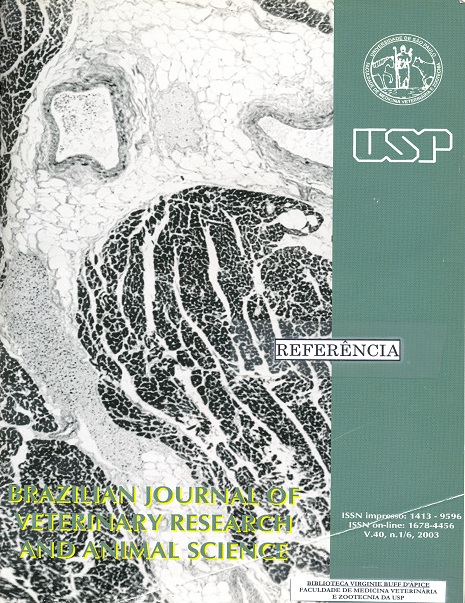Influence of pregnancy and puerperium in the erythrogam of Saanen goats (Capra hircus), raised in the State of São Paulo - Brazil
DOI:
https://doi.org/10.1590/S1413-95962003000300003Keywords:
Erythrogram, Pregnancy, Puerperium, Caprine, Saanen goatsAbstract
The influence of pregnancy and puerperium on the erythrogram of Saanen goats (Capra hircus) was evaluate on blood samples were taken from 150 goats raised on the State of São Paulo and were allocated into 5 experimental groups of 30 goats each as described: non-pregnant; initial pregnancy (30 -| 60 days of pregnancy); middle pregnancy (60 -| 120 days of pregnancy); late pregnancy (more than 120 days of pregnancy); kidding goats (until 30 days after parturition). The blood samples were collected with EDTA and submitted to the following analysis: erythrocyte counts (at the modified Neubauer hemocytometer, using Gower's liquid as a dilute); packed cell volume (using the microhematocrit method); hemoglobin concentration (using cyanmethemoglobin method); calculated blood indices: MCV - mean corpuscular volume; MCH - mean corpuscular hemoglobin; MCHC - mean corpuscular hemoglobin concentration. Although lower number of erytrocytes were seen at the end of pregnancy, the blood values returned to normality during the kidding phase. These values returned to those observed in non-pregnant goats, goats in early and middle pregnancy. The evaluation of the hemoglobin concentration and packed cell volume did not show any significant variation that could be attributed to pregnancy or the puerperium. The MCV and MCH values were higher in goats in late pregnancy and during kidding.Downloads
Downloads
Published
2003-01-01
Issue
Section
UNDEFINIED
License
The journal content is authorized under the Creative Commons BY-NC-SA license (summary of the license: https://
How to Cite
1.
Viana RB, Birgel Junior EH, Ayres MCC, Benesi FJ, Mirandola RMS, Birgel EH. Influence of pregnancy and puerperium in the erythrogam of Saanen goats (Capra hircus), raised in the State of São Paulo - Brazil. Braz. J. Vet. Res. Anim. Sci. [Internet]. 2003 Jan. 1 [cited 2025 Apr. 9];40(3):178-84. Available from: https://revistas.usp.br/bjvras/article/view/11348





